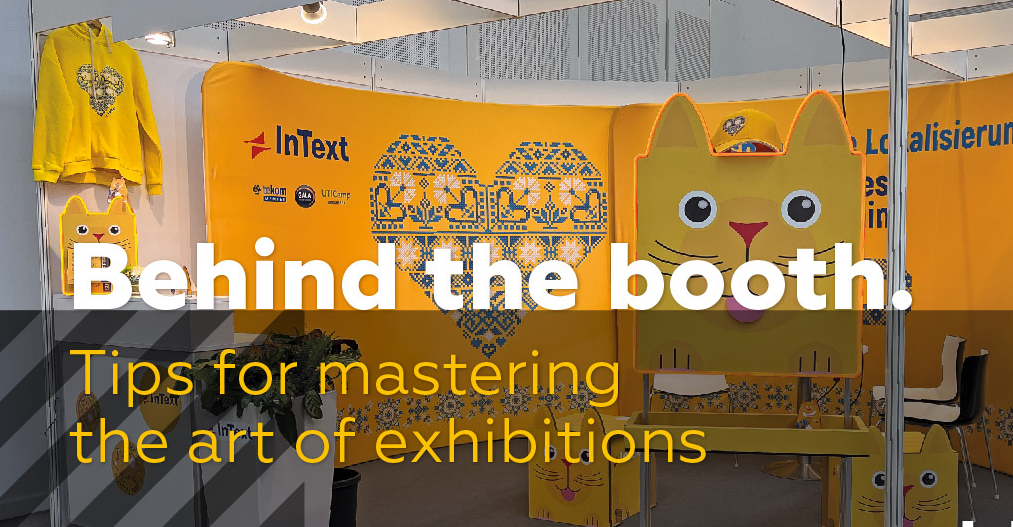
This article was originally published on multilingual.com.

Exhibitions offer a unique opportunity to create lasting impressions, transforming casual interest into tangible value. They allow you to engage face to face with existing clients and potential leads, showcase products, and build strong relationships. As a result, months of meticulous preparation can lead to projects worth significant sums.
When I first joined InText, a localization and desktop publishing company, the marketing department was abuzz with preparations for tekom fair, Europe’s largest technical communication event. As a marketing newcomer tasked with finding a Ukrainian sweets supplier in Germany, I wondered if such requests are routine for marketers in the localization industry. I soon found out that exhibition preparation is about promotion, logistics, production details, and a lot of teamwork.
Preparing for an exhibition typically requires three to seven specialists, including marketers, graphic designers, sales managers, and production experts. Drawing from our experience at events like tekom fair, LocWorld, and game localization conferences, we’ve developed a comprehensive approach to exhibition success.
Here’s a detailed look at how we prepare for successful exhibitions, including unique tips for your own journey.
Once you’ve selected the exhibition — or been assigned to one — and confirmed its potential for lead generation, it’s time to prepare. Here’s how to begin.
Find as much information about the exhibition as possible. Gather details such as dates, locations, useful contacts, white papers, feedback, deadlines, and material guidelines. Don’t hesitate to contact event organizers if you can’t find certain information — they can often provide more assistance than you might expect.
Next, identify key resources that will be useful during preparation. This includes:
By defining the required resources early, you can create a solid exhibition strategy. This will guide your decision-making and resource allocation throughout the preparation process, ensuring a focused and effective approach to the event.
With your resources identified, it’s time to develop a concept. In the context of an exhibition, this is the idea you want to convey to attendees. Ideally, the concept should align with your company’s identity and tell a story about your business.
Perhaps your company wants to be seen as a formal business-oriented team. Or maybe you’d prefer to be perceived as a cheerful team that clients see as friends rather than just business partners. This choice will influence your concept, which will shape the designs of your banners, handouts, leaflets, merchandise, social media posts, and more.
Attention is a valuable currency today. People are bombarded with social media, advertisements, music, and other forms of entertainment, leaving little attention for exhibitors at yet another event. Therefore, the main task of a successful exhibition concept is to attract attendees’ attention. You need to stand out among other exhibitors, catch the eyes of visitors, and effectively communicate with them once they’re drawn to your stand.
Let’s spice up the story with some examples.
At tekom fair 2022, InText laid the foundation for our new exhibition concept that you may have noticed at recent localization industry events. When creating the concept, our team wanted to show our gratitude for the world’s support of Ukraine (as InText is a Ukrainian-founded company) and apply the national Petrykivka folk art style, which we use extensively in our corporate branding.
Our marketing team came up with the idea of using bright yellow and designing a big heart in the Petrykivka style. At the fair, everyone noticed and talked about our bright themed stand. We managed to attract lots of attention and achieve high visibility. Our colorful design helped us make new connections and get new work requests.
This example demonstrates how a well-crafted concept can effectively communicate your brand identity while creating memorable interactions with potential clients.
A concept is great, but you can’t go far with a concept alone. You need marketing materials that incorporate the concept while providing useful information. At this point, your marketing team will need to activate their creative side and imagine as many engaging ideas as possible.
Effective exhibition materials typically fall into four categories:
To maximize your impact, aim to include items from all four categories. This approach ensures you not only promote your company but also provide true value to potential clients.
Here’s a sample list of materials based on our recent experience at LocWorld51 in Dublin, Ireland:
Use this list as a starting point for your next exhibitions, adapting it to fit your specific concept and your audience’s needs.
With your concept and list of materials in hand, you’re ready for the most time-consuming stage: bringing your plans to life. This involves close collaboration with other departments within your company, including sales and production, to create impactful and error-free marketing materials.
Here are the steps involved:
This structured approach ensures that your marketing materials are well-prepared and delivered on time, contributing to a successful exhibition.
You are very close to the grand day of the exhibition. Your materials have been shipped to the destination; team members are preparing to talk with stand visitors. You might think: Well, that’s enough of me. The work is done. However, we want the exhibition to be successful, right?
If you want to maximize your stand’s attendance, you should conduct a PR campaign. This includes a massive bombardment of posts on social media, articles, blog posts, website banners, press releases, and news in managers’ email signatures. Use every possible way to promote your participation and make the most of your experience. Implementing a content plan will help you maintain an organized approach to social media posts. Consider what you will share before, during, and after the event. Exhibitions are a great opportunity for high engagement and visibility on LinkedIn, Instagram, Facebook, Twitter, and other platforms.
Finally, don’t forget about your team members. Your marketing materials are only as effective as the people representing them. Make sure everyone knows the plan of action and how to use all the marketing resources. You may want to assist your sales managers by providing them with a script for sales conversations and a guide on how to talk about your company in line with your brand guidelines.
And remember: impulsive last-minute decisions can still happen. Be prepared for your managers to come up with late ideas that you may need to implement promptly. Quick adjustments can often lead to great opportunities.
Congratulations! You’ve made it to the big day. After months of preparation, it’s finally time for the exhibition.
Wish your team members luck, stay in touch with them throughout the event, and be ready to answer any questions they may have. Also, be prepared to promptly post updates on social media to give your followers a real-life experience.
For marketers, this stage is mostly calm and short, as all the groundwork has been completed in the preceding months. Enjoy the event and celebrate the culmination of your hard work!
For sales managers, the fun part is only starting. Working hours during the exhibition will greatly exceed the usual eight, and communication with people will never seem to stop. Here are tips from our sales team on how to successfully manage an exhibition stand:
Make the most of every interaction, and don’t forget to enjoy the experience!
The final crucial stage is to collect feedback from your colleagues and assess the outcomes of the event. This helps you learn from your experience and improve your approach to future events. We typically start by writing down our own feedback, then present it to others. Finally, we compile a comprehensive presentation about the event along with future ideas for the entire InText team.
For a productive debriefing session, consider the following questions:
Over time, you may forget details such as which supplier produced low-quality merchandise or which aspects of your leaflet were most appreciated by clients. To ensure continuous improvement in our exhibition participation, our marketing department always reviews debriefings from previous exhibitions. This helps us refine our strategies and enhance our event planning.
By conducting a thorough debriefing, you can gather valuable insights, identify areas for improvement, and build on successes for future exhibitions.
Challenges are a normal and important part of the event planning process. No amount of planning or management can eliminate them completely. Here are some real-life examples from our experience.
For LocWorld49 in Malmö, Sweden, we discovered just three weeks before the event that our booth was 4x2 meters, not 4x4 as we had believed. Despite this unexpected realization, we managed to fit all the materials into the smaller booth and draw the attention of a lot of visitors. Since then, we’ve made it a priority to double-check the booth size early in the planning process.
Now, let me pull back the curtain on our most stressful situation. Logistics can often be the dark side of preparation. Matters are further complicated by the ongoing war in Ukraine, where our main office is located, and the fact that exhibitions are held in various countries. Once, our logistics company couldn’t locate the area where our materials were to be stored before an exhibition. The driver and the security team decided that the best solution was to place our boxes in an unknown room on the warehouse premises. That night, our marketing department couldn’t sleep at all. Thankfully, by morning, warehouse workers found our boxes safe and sound. Remember to develop contingency plans for logistics, especially when dealing with international shipments or complex situations.
By sharing these real-world challenges, I hope to provide a realistic view of exhibition preparation. Each setback taught us valuable lessons and helped us refine our approach, ultimately contributing to our success at future events. It’s not about avoiding all problems but about how you handle problems when they arise.
They say localization is an art. Well, I believe exhibition planning and execution is an art form too, blending creativity, project management, and adaptability. It requires prompt and authentic teamwork, with every member dedicated to a common goal and ready to support one another.
What challenges await us at upcoming exhibitions? To our mind, it’s striking the right balance between reusing proven materials and introducing fresh, exciting elements for stand visitors. Additionally, optimizing logistics and packing processes remains a significant challenge given their time-consuming nature.
Exhibitions can sometimes feel chaotic (they remind me of the “This Is Fine” meme, in which a dog sits in a room that’s engulfed in flames while assuring himself that everything is fine). However, with each exhibition, you have an opportunity to sharpen your skills and achieve greater success. By following the stages outlined in this article and learning from past experiences, you can learn how to effectively prepare for and participate in an exhibition.
The next time you spot our team in bright yellow hoodies with cats, remember this article and the journey behind our presence. Until our paths cross at the next exhibition, keep refining your art!